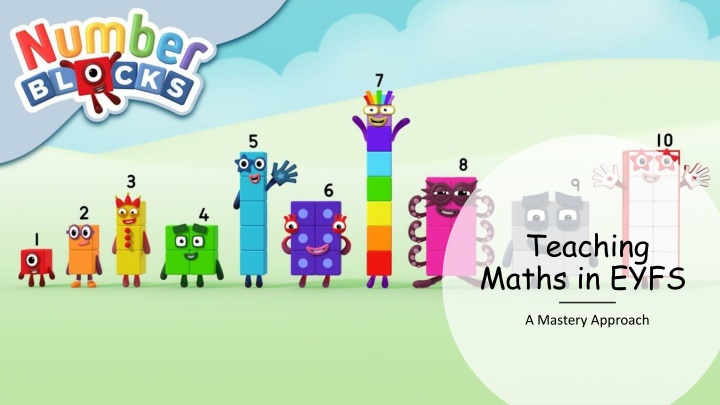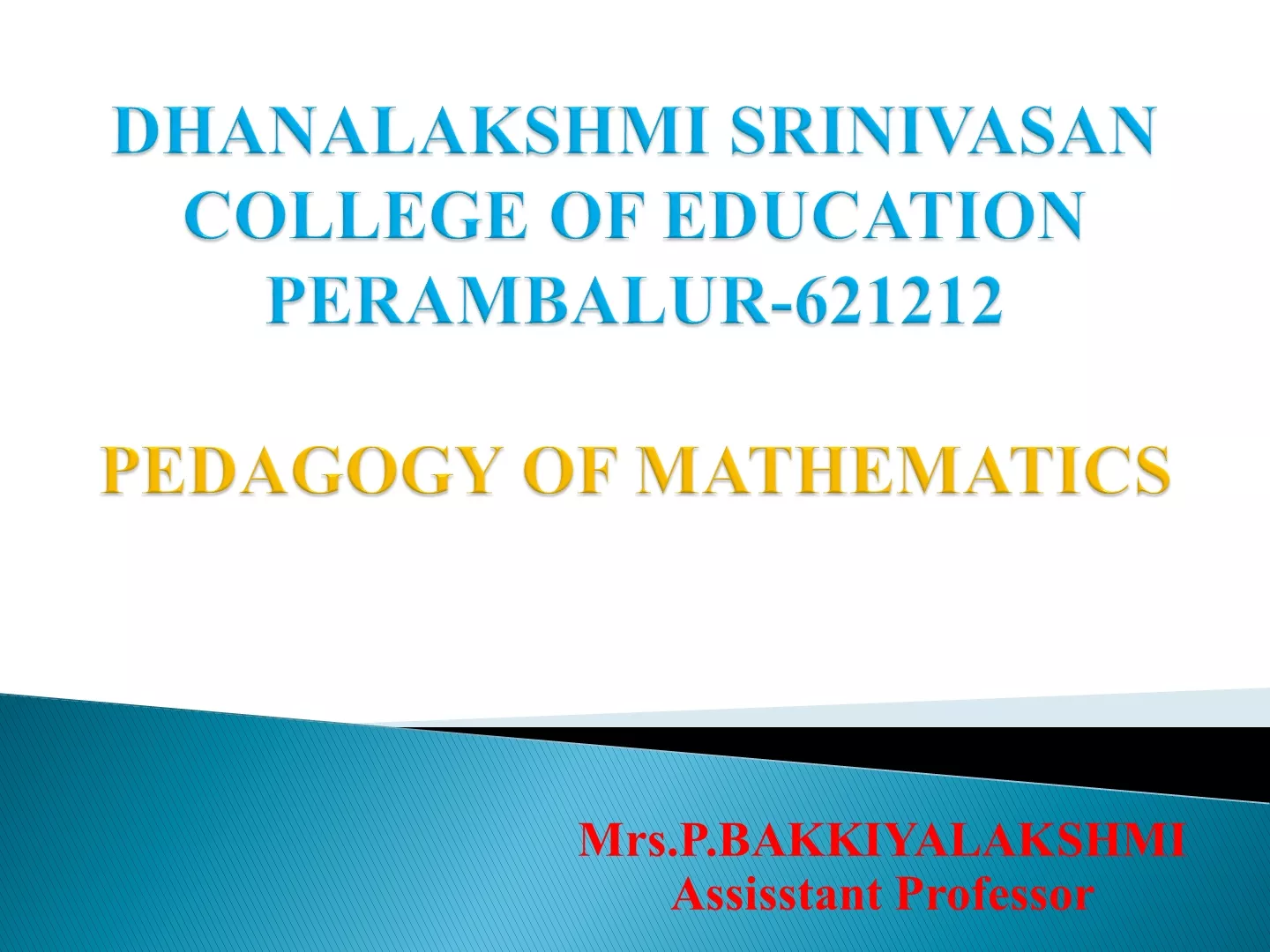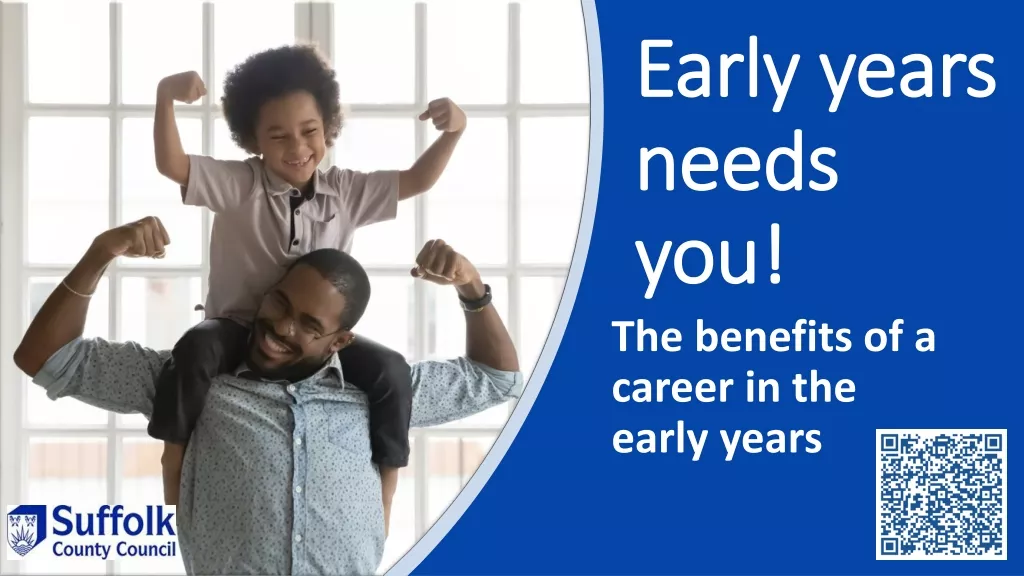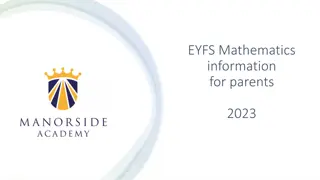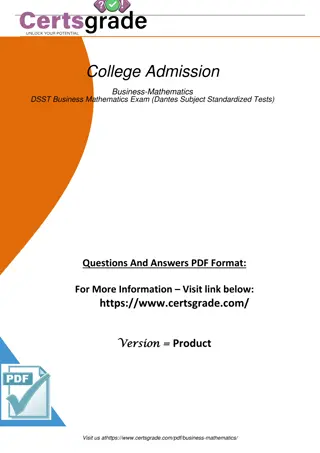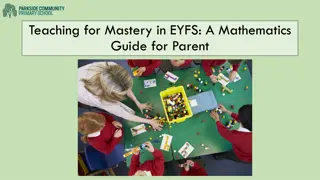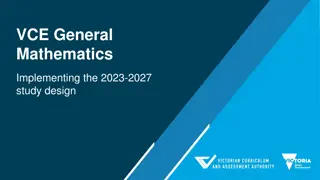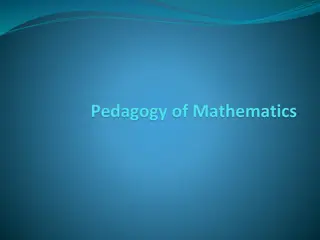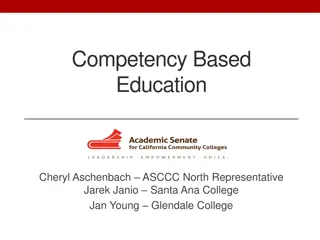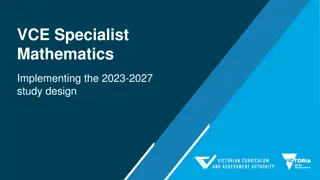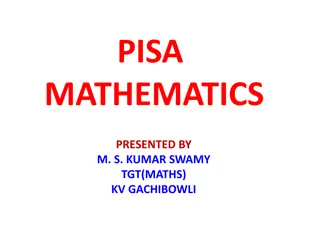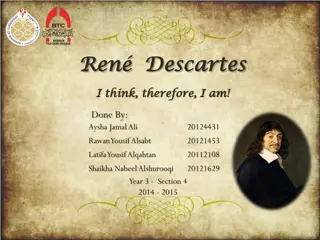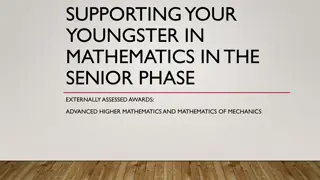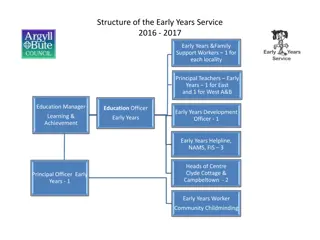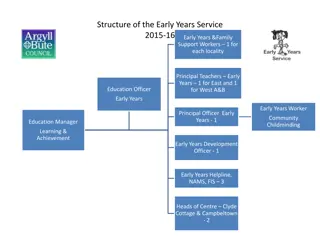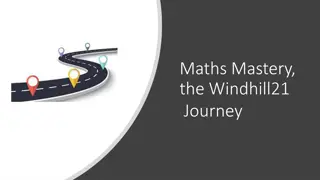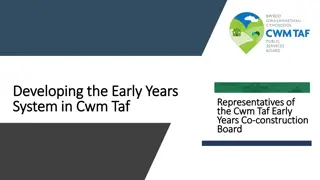Implementing Mathematics Mastery in Early Years: A Comprehensive Approach
Embracing a mastery approach to teaching mathematics in Early Years Foundation Stage (EYFS) focuses on providing children with a deep understanding of mathematical concepts, enabling them to progress confidently. The EYFS mathematics curriculum encompasses various key areas such as shapes, space, numbers, counting, addition, subtraction, and more. Teaching for mastery involves breaking down math objectives into manageable steps, emphasizing fluency, reasoning, and problem-solving skills. Strategies include promoting number sense, representing numbers in different ways, and instilling key counting principles.
Download Presentation

Please find below an Image/Link to download the presentation.
The content on the website is provided AS IS for your information and personal use only. It may not be sold, licensed, or shared on other websites without obtaining consent from the author.If you encounter any issues during the download, it is possible that the publisher has removed the file from their server.
You are allowed to download the files provided on this website for personal or commercial use, subject to the condition that they are used lawfully. All files are the property of their respective owners.
The content on the website is provided AS IS for your information and personal use only. It may not be sold, licensed, or shared on other websites without obtaining consent from the author.
E N D
Presentation Transcript
Teaching Maths in EYFS A Mastery Approach
EYFS Maths curriculum Shape, Space & Measure Patterns Shape Size Position Time Money Number Counting Ordering Number recognition Addition Subtraction Doubling Halving Sharing
There are two Early Learning Goals for maths. This is what most children in Reception are expected to be able to do by the end of their first year at school. Number: Children count reliably with numbers from one to 20, place them in order and say which number is one more or one less than a given number. Using quantities and objects, they add and subtract two single-digit numbers and count on or back to find the answer. They solve problems, including doubling, halving and sharing. Shape, Space and Measure: Children use everyday language to talk about size, weight, capacity, position, distance, time and money to compare quantities and objects and to solve problems. They recognise, create and describe patterns. They explore characteristics of everyday objects and shapes and use mathematical language to describe them.
What is Teaching for Mastery? At (Aberford C of E Primary School) we see Teaching for Mastery in maths as allowing the pupils to gain a deep understanding of maths, allowing them to acquire a secure and long-term understanding of maths that allows them to make continual progress to move onto more complex topics. We believe that everyone can do maths and there s no such thing as a maths person. Maths is a subject that everyone can and should be able to perform confidently and competently. Teaching for Mastery We choose to teach by breaking down maths objectives into the smallest steps, so that every pupil is secure in every new concept before moving on. We focus upon teaching for fluency, reasoning and problem solving.
How do we teach for Mastery in Early Years? Fluency - In Reception we aim to teach so that children have a deep understanding of number. Representing Numbers We want to develop children s number sense so that they understand the number rather than just recognising the numeral. Children need to understand that numbers can be represented in many ways, not just as a written numeral. We use many different objects and pictures to show that numbers can be represented in lots of ways. Children sometimes need lots of practise to recognise numbers in different forms. We play games that encourages children to recognise and make different amounts in our indoor and outdoor areas.
Counting When counting, children need to understand these key principles That we need to say one number for each object counted (touch counting / One-to-one correspondence match one number name to each item to be counted Stable order- say the number names in the correct order Cardinality the last number in the count is the total size of the group. The final number we say is how many altogether. Some children continue to count after they have reached the final object as they don t connect the numbers they are saying to the objects in front of them. That we can count objects in any order and the total stays the same.
Recognising amounts subitising Another skill is to Develop other mental strategies to identify the number of items in a group without counting them individually e.g. 6 dots on a die: seeing this as two groups of three which we combine to make 6 Initially this should be by using concrete objects such as those shown above but as children progress, allowing them to see groups of dots in different arrangements helps them to mentally see how many objects are there without needing to count. This is a very important skill when children begin to add and subtract. Using dice is a good way to practise this skill before moving onto objects in different arrangements.
Understanding that the total stays the same even when the objects move When children first start to use numbers, they often do not understand that if we move objects into another arrangement the total stays the same. We practice this with many different types of objects but a useful tool is using a tens frame to be able to move counters around.
Reasoning Reasoning in maths helps children to be able to explain their thinking, therefore making it easier for them to understand what is happening in the maths they are doing. It helps them to think about how to solve a problem, explain how they solved it and to think about what they could do differently. In Reception and Nursery, some examples of reasoning are: True and false statements eg adding one to a number always makes it smaller Spotting incorrect maths eg 1, 2, 3, 4, 6, 5, 7, 8, 9, 10 Explaining how we know something or how we worked it out .
Which cookie is the odd one out? And why?
This naughty alien is stealing numbers from the number lines, then putting them in his bag. Which three numbers would you find in his bag?
Problem Solving Problem solving in maths allows children to use their maths skills in lots of contexts and in situations that are new to them. It allows them to seek solutions, spot patterns and think about the best way to do things rather than blindly following maths procedures. In Reception, problem solving might include: spotting, following and creating patterns estimating amounts of objects predicting how many times they can do something in a minute sharing objects between different groups particularly when the amount of groups change and the amount of objects stays the same finding different ways to partition numbers eg 5 could be 5+0, 4+1, etc Parent TASK Can you show another way to make 5 on your tens frame?
What is Part-Part Whole? The Part-Part Whole model is the concept of how numbers can be split into parts. Children using this model will see the relationship between the whole number and the component parts, this helps learners make the connections between addition and subtraction. Part-Part Whole reasoning also helps pupils to interpret, visualise and solve word problems. The concept of part-whole model reasoning is introduced to children as early as 3/4 years old. It is used in small quantities where children should be able to see how many of something is there without counting, instead, they will subitise. https://www.youtube.com/watch?v=vzeeaxLQDkE
What a maths session may look like in Class One. Learning Objective: I want the children to Recognise and talk about the numeral 4. See the relationship between four and three. Use sentences to describe the relationship four is made of three and one four take away one leaves three https://www.ncetm.org.uk/resources/52060
How can I help at home? Count - steps up the stairs, money into a money box etc Ask children to say how many without counting (5 or fewer) Play games using dice/dominoes and encourage child to say how many spots without counting. Ask children to set the table with enough knives, forks and plates for everyone. Spot numbers in the environment on phones, microwaves, clocks, registration plates, doors. Ask children to think of their own representations for numbers eg one of them, two hands, three bears, four wheels on a car, five toes, six sides on a dice, seven dwarves, eight legs on an octopus etc Deliberately make mistakes. Children need to understand mistakes are normal and everyone makes them eg get mixed up when counting, muddle two numbers when ordering them. Watch Numberblocks on Cbeebies. This programme is written by maths specialists to model maths concepts and represents number brilliantly. Also, Numberjacks is excellent for solving problems. Hide numbers around the house or garden for children to find. Play outdoor maths games like hopscotch and skittles. Even better, let children make up their own games and decide how to score points. Read books with maths concepts eg The Very Hungry Caterpillar, One is a snail, ten is a crab, What s the time, Mr Wolf? The doorbell rang. Draw attention to more and less. Try some activities from the NRICH website for EYFS to encourage depth - www.nrich.maths.org (please be mindful that we will be using some of these in school) Ask questions such as How many more? , How many altogether? , How many would I have if
